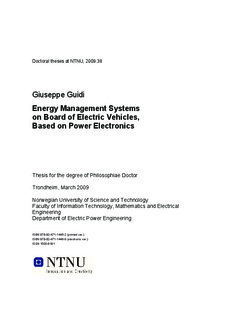| dc.description.abstract | The core of any electric vehicle (EV) is the electric drive train, intended as the energy conversion chain from the energy tank (typically some kind of rechargeable battery) to the electric motor that converts the electrical energy into the mechanical energy needed for the vehicle motion.
The need for on-board electrical energy storage is the factor that has so far prevented pure electric vehicles from conquering significant market share. In fact electrochemical batteries, which are currently the most suitable device for electrical energy storage, have serious limitations in terms of energy and/or power density, cost and safety. All those characteristics reflect in pure electric vehicles being outperformed by standard internal combustion engine (ICE) based vehicles in terms of driving range, time needed to refuel and purchase cost.
Electric vehicles do have their distinctive advantages, being intrinsically much more efficient, operating at zero emissions at the pipe, and offering a higher degree of controllability that can potentially enhance driving safety. No wonder then, that electric energy storage technology has attracted considerable R&D investments, resulting in new traction battery packs that are getting closer and closer to the industrial targets. In this scenario of EV technology gaining momentum, power electronics engineers have to come up with newer solutions allowing for more efficient and more reliable utilization of the precious on-board energy that comes in a form that cannot be directly utilized by the motor. At present, most of the research in the area of power electronics for automotive is focused in volume and cost reduction techniques. The increase in power density is pursued by developing components that can be operated at higher temperature, thus relieving the requirements on cooling.
In this thesis, the focus is on the development of alternative topologies for the power electronics converters that make use of some peculiarities of the energy storage components and of the electrical drive train in general, rather than being a mere component-level optimization of well established topologies.
A novel converter topology is proposed for hybridization of the energy source with a supercapacitor-based power buffer being used to assist the main traction battery. From the functional point of view, the topology implements a bidirectional DC/DC converter. Making use of the fact that the battery terminal voltage is close to constant, an arrangement for the supercapacitors is devised allowing for bidirectional power flow by using power electronics devices of lower ratings than the ones needed in conventional DC/DC converters. At the same time, much smaller magnetic components are needed. Theoretical analysis of the operation of the proposed converter is given, allowing for optimized design. A full-scale experimental prototype rated at 30 kW, intended for use in a pure EV, has been built and tested. Results validate the theory and show that no particular impediment exist to the deployment of the concept in practical applications. Another concept introduced in the thesis is an architecture where the traction inverter is embedded in the energy storage device. The latter is constituted by several modules, as in the case of modern Li-ion battery systems, and each module is equipped with a local power electronics interface, making it functionally equivalent to a controllable voltage source. The result is a modular, distributed system that can be engineered to have very high reliability and also to exhibit self-healing properties. A prototype with a minimum number of modules has been built and tested. Results confirm the effectiveness of the system, and make it a good candidate for deployment in applications where reliability is the most important requirement. | nb_NO |

